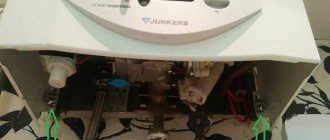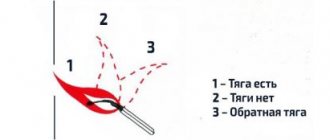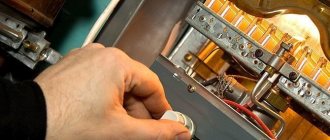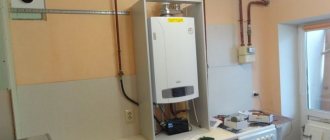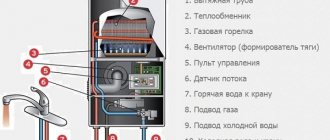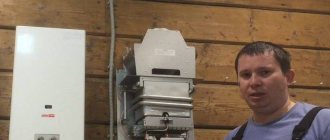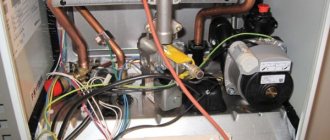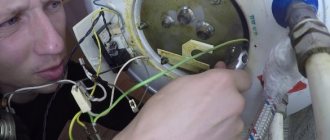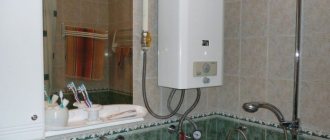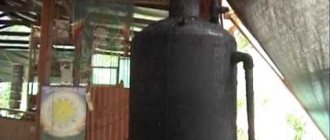There are three ways to ignite Bosch speakers:
- Piezo ignition. It is used in such Bosch models as WR 10-2P, W 10-2 P, WR 13-2P, WR 15-2 P.
You need to press the power adjustment slider on the front panel, and at the same time press the piezoelectric ignition button from below. After a few seconds, the wick lights up, you need to release the slider and select the desired power level (to the right - more heating).Then the water supply is adjusted using the knob on the right. This type of ignition is called semi-automatic.
- Electric ignition. Used in the following models of Bosch water heaters: W 10 KB, WR 15-2 B, WR 10-2 B, WR 13-2B. First of all, you need to install two “R20” batteries with a voltage of 1.5 V into the battery compartment at the bottom.
There is an LED on the front panel that indicates the charge level. After installing the batteries, press the power button on the speaker.In order for the water heater to work, just turn on the hot water tap.
- Hydro turbine. Installed in Bosch WRD 13-2 G, WRD 10-2 G, WRD 15-2 G models. In this case, the column ignites automatically due to water pressure. To get started, simply open the tap and, if the water pressure is strong enough, the water heater will automatically start working.
Fault prevention
What should I do to ensure that the water heater works as long as possible and there are no problems with ignition? Most problems with the ignition of a Bosch column can be avoided by following operating and safety rules.
Here are the main ones:
- With Bosch, it is important to consider the presence of a good chimney and ventilation in the room. Be sure to open the window slightly while the water heater is operating.
- Regularly carry out inspections and checks of traction force, filter contamination and radiator cleanliness.
- Do not mix cold water with hot water.
- Do not load the column as much as possible. Bosch speakers can heat water up to a temperature of 68 degrees. But for use at home, 30-45 degrees is enough. High temperatures sharply reduce the service life of the column and contribute to its rapid contamination with soot.
- Install additional water filters at the inlet to reduce clogging of the water heater system.
It is not always possible to eliminate malfunctions due to which the gas water heater does not light up when you turn on the water. Some breakdowns require the involvement of a specialist. On the other hand, the cause of problems in the operation of a water heater is not always associated with the failure of internal components and modules. You can fix minor damage with your own hands.
Why does the gas water heater not light up?
The geyser is perhaps the most common water heating device in a modern home. It is often installed in housing where there is no central heating or hot water supply. This is a fairly convenient unit, easy to operate and allows you to independently regulate the level of financial costs for heating water. Today, the consumer has the opportunity to choose a geyser from among a variety of options that can satisfy any operating conditions and any financial capabilities. There are a large number of different models of varying levels of complexity with and without additional functions - everything is done to make this type of device as easy to use, as profitable as possible and, of course, as safe as possible for the consumer.
Causes of problems with starting the column
To identify the malfunction and eliminate it, you will need to analyze the operation of the equipment. Masters pay attention to the following signs:
- there is no spark from the piezoelectric element or the igniter does not work;
- the burner lights up, but not the first time or goes out periodically;
- the water regulator (frog) is leaking;
- The speaker turns on with a bang.
In normal condition, the water heater operates almost silently and operates with a delay of no more than 1-2 seconds after opening the water draw-off point. Below are the main signs that help diagnose the cause of the breakdown and how to fix the problem.
The piezoelectric element does not produce a spark
One of the common problems. The malfunction can be expressed in several manifestations:
- There is no spark in the gas column - the reason: failure of the piezoelectric element, electrode or its displacement. A similar malfunction is observed in cases where the piezoelectric element does not turn off (approximately 30 seconds). After this, the ignition wick goes out. Repair, if the piezo ignition does not work, consists of replacing the unit.
- There is a spark, but the column has stopped igniting - the reason is simple non-compliance with operating rules. Before pressing the ignition button, you must hold down the gas handle for about 10 seconds. There is a security system inside the water heater. Until the igniter warms up, the gas supply to the burner device will be blocked. 10 seconds of pressing the feed handle is usually enough to light the wick. If the piezoelectric element does not work, although a spark is present, you should re-read the manufacturer's instructions and light the wick in accordance with the instructions given.
- The wick does not burn - the breakdown is due to the failure of the automation or insufficient draft in the chimney. The cause of the malfunction is also a dirty igniter that needs to be cleaned. When gas is burned, soot settles on the device. There is a spark, but the wick stops burning immediately after the forced gas supply is turned off. Cleaning the igniter (should be serviced every year) will help eliminate the problem.
Replacing or adjusting the piezoelectric element requires the necessary tools and appropriate skills. For repairs, it is better to use the service of service workshops, or invite a specialist to your home.
No power to igniter
In this case, the geyser, powered by batteries or a hydrogenerator, does not turn on when the water is turned on. A malfunction can be caused by a failed diaphragm of the water unit (described below), but more often the reason lies in the following:
- The batteries are low - the spark fires, but its power is not enough to ignite the burner. The column does not turn on immediately, does not light up for a long time, and the electric ignition is constantly activated. If the battery-powered speaker does not turn on or stops responding to the opening of the water tap, the first thing to do is replace the batteries.
- The hydrogenerator does not work - this is a turbine that generates electricity from the movement of water supplied to the water heater. The unit is sensitive to water quality and pressure. If the hydrogenerator refuses to work, it is necessary to clean the internal device from dirt and deposits. The problem is solved in 80% of cases. The pressure required for turbine operation is stabilized using special booster pumps for water supply.
- The power supply is a common cause of a malfunction if a gas water heater with automatic ignition does not light up. The lack of spark is due to power failure. There are several reasons for the malfunction: contacts have oxidized, resistors have swollen. If you know how to solder, you can fix the damage yourself. More often the power supply is simply replaced with a new one.
Even high-quality batteries, provided that the water heater is used intensively, last only 6-8 months. After this, the column begins to malfunction.
Lack of sufficient water pressure
The technical documentation of water heaters clearly states the throughput capacity.
The minimum pressure at which the column must operate is given. If the burner does not turn on when the water pressure is low, the reason is not always a faulty equipment. The problem may be hidden in non-compliance with technical specifications. Operation can be normalized by installing a storage tank and a booster pump. As for automatic heat generators operating on batteries or from the mains, low water pressure leads to the fact that the water unit (frog) does not work. The principle of operation of the regulator is that inside its cavity is divided into two parts by a membrane. In one cavity there is a rod that regulates the gas supply and turns on the ignition of the burner. The rod is driven by pressure from the membrane. If there is insufficient pressure, the rod remains in place and, as a result, there is no spark in the automatic column, and the gas supply to the burner is closed.
Advantages and principle of operation of a gas water heater with piezo ignition
The semi-automatic column is ignited using two burners: pilot and main. The pilot is an igniter that constantly maintains combustion, regardless of whether the tap is turned on. The main burner ignites only when the DHW tap opens.
The operating principle of a gas water heater with piezo ignition is as follows:
- press the piezo ignition button located on the front panel and hold it pressed for about 30 seconds;
- the pilot burner lights up;
- then the DHW tap is opened, and gas begins to flow from the pilot burner to the main burner;
- While the water flows out, both burners burn;
- after closing the tap, the main burner turns off, and the pilot burner continues to burn.
Geysers with piezo ignition have their advantages and disadvantages. The advantages include:
- affordable price;
- independence from electricity;
- a mechanical regulator allows you to independently change the flame strength;
- simple device;
- inexpensive repair.
Minuses:
…
- a burning pilot burner wick leads to excessive gas consumption;
- low level of comfort during operation due to the need for frequent human intervention, in particular manually turning on a periodically extinguishing igniter.
Find out here, is it possible to use a gas water heater for heating?
Gas water heaters ZANUSSI - characteristics and models
Operation of a propane gas water heater
The security system of a device with piezo ignition includes the required minimum:
- flame presence control;
- temperature sensor;
- smoke exhaust thermostat.
When a signal is received that there is no flame, the maximum temperature is exceeded, or the smoke concentration is high, the column stops working.
…
Burners with electric ignition are more progressive and convenient to use. They have a high level of comfort and save fuel. The automatic water heater maintains the required level of water heating using modern automation.
Types of burners
One of three types of burners can be installed in the column:
- single stage;
- two-stage;
- modulation.
The first two options are becoming less common, as consumers prefer to buy a device with a multi-stage burner. It can be switched to different power levels using a mechanical regulator. This allows you to more clearly control the level of water heating and significantly saves gas.
Finding and eliminating causes
So, why doesn’t the gas water heater turn on? A number of situations could be to blame:
- Error in connecting pipes;
- Lack of draft in the chimney
; - High sensitivity protective relay
; - Low ignition system batteries
; - Weak water pressure or its complete absence
; - Filter contamination
; - Membrane deformation
.
Let's consider all the listed reasons in more detail and look at effective methods for eliminating them:
Reason #1: error in connecting pipes
The water heater protection system itself shuts off the gas supply if errors are made in connecting the pipes. To prevent this from happening, simply stick to a simple and clear scheme:
Also, if gas does not flow into the gas column, check the position of all shut-off valves that may be installed on the gas pipeline. It is possible that after installing the device you simply did not open one of the taps.
Reason No. 2: lack of draft in the chimney
Due to contamination of the chimney as a result of the accumulation of soot or construction debris entering it, the vector of movement of combustion products changes to the opposite direction. This poses two dangers:
- The returning mixture of carbon monoxide and air extinguishes the burner
. As a result, the protection system is triggered and the operation of the gas water heater is blocked;
- The returning mixture of carbon monoxide and air penetrates into living spaces
. This option is even worse, as it poses a danger to the health and even the life of household members. It is possible in the case when the force of the “overturned” draft is not enough to extinguish the fire.
It is very easy to check the condition of the ventilation duct with your own hands. It is enough to bring a lit match to the inlet hole: if the flame deviates inward, it means that the chimney is working effectively, but if not, appropriate measures must be taken.
Let's figure out what to do in the described situation:
| Photo | Description |
| First of all , check if someone has installed a satellite dish above the exit of the ventilation shaft. This may be quite enough to create a backdraft effect. In this case, the problem can be solved by negotiations with neighbors without calling chimney cleaning specialists. | |
| Call a professional to clean the ventilation duct. If no external factors interfere with the exit of combustion products, then the reason for the lack of draft is clearly a clogged chimney. You can try to clean it yourself, but there is a danger that without the appropriate experience you will damage neighboring branches with your actions. |
Reason #3: high sensitivity of the protective relay
Does the gas heater light up and then quickly go out? In this case, the problem most likely lies in the oversensitive relay, which triggers protection against overheating. There are two options to solve the problem:
- Temporary
. You should open the window to reduce the temperature in the room;
- Radical
. The problem can be finally solved only by replacing the relay.
Reason No. 4: discharged ignition system batteries
Another reason why the main burner does not light up may be dead batteries. This can be determined by the idle clicks of the piezo ignition element when hot water is turned on.
It is also worth noting that the described problem applies exclusively to water heaters equipped with an automatic switching system.
Reason No. 5: insufficient water flow or its complete absence
In order for the geyser to turn on, there must be a certain amount of water pressure present. If it is too weak, the unit will not turn on. In this case, you should first clarify the source of the problem by opening the cold water tap in the bathroom:
- If the water supply level there is weak
, it means that the problem is in the city water supply system. There is nothing you can do here, you will have to wait;
- If the liquid flows normally
, most likely the column itself is clogged.
In the second case, you can call a technician, or you can try to clean the device yourself. The instructions look like this:
- Shut off the gas supply
; - Unscrew the pipes
;
- Remove the gas water heater from its hinges
;
- Place it upside down on the table
; - Use a syringe to pour a special cleaning liquid inside.
The price of such a mixture is not very high, and it can be purchased at any specialized store; - Leave the unit for a couple of hours
.
Reason #6: dirty filters
Another reason for the column to malfunction can be dirty filters. Scale, rust and other insoluble impurities clog the grates over time, and they need to be cleaned. In this case, we are talking not about one object, but about several at once:
| Photo | Filter name and location |
| The water unit is in the column itself . In some cases, it can be cleaned using the method described above, in others you will have to disassemble the device and clean the grille manually or completely change it. | |
| Coarse filter . It is located on the pipe that supplies cold water to the water heater. | |
| Filter on mixer . |
Reason #7: membrane deformation
The gas water heater also does not work if cracks, ruptures or other deformations appear on the membrane. In this case, it is necessary to replace it.
Instantaneous gas water heaters, or in other words - geysers, allow you to obtain hot water in domestic conditions and use it for its intended purpose. Despite all the conveniences they provide, these units are not without weaknesses, as they break down from time to time.
If the gas water heater does not light, then to eliminate the consequences of the malfunction you need to call a technician or try to fix the device yourself. But before you do anything, you should understand the reasons for the breakdown.
Since most models of gas water heaters have the same device (they work on a similar principle), the inability to start them is explained by the following typical reasons:
- no ignition (no normal spark);
- normal draft in the air outlet is disrupted;
- water is supplied with low pressure;
- coolant (gas) pressure is weakened;
- accumulation of scale and blockages;
- problems with the electronic protective module.
In cases where the dispenser has not been used for a long time, the cause of its malfunction may be the accumulation of a large amount of air in the gas pipeline. To remove air pockets, it is enough to bleed them briefly (for a minute or a little more).
Let's look at each of the reasons indicated above, explaining why the gas water heater goes out in more detail.
Due to a malfunction of the working parts, the wick of the geyser does not light up
If you cannot light the pilot, you need to check the draft by following the flame of a match. If it is not present in the chimney, a special control system is activated, cutting off the flow of fuel. It is necessary to clean the chimney, remove objects that prevent the combustion product from escaping. Specialists from the Neva gas water heaters service center will help you cope with this problem.
- Improper ventilation should not be confused with lack of draft. The unit has electromagnetic valves - a kind of gas control. A faulty ventilation system will cause carbon monoxide to enter the room.
Thanks to the solenoid valve, the fuel is shut off and the wick of the Mora geyser goes out.
No ignition
If for some reason the column does not light up at all, you should first check the battery that powers all the electronics (including the piezo ignition system).
When operating the water heater from a built-in generator, you should make sure that the piezoelectric element is in good condition, as well as that there are no breaks in the supply wires. In addition, it is necessary to inspect the electrode (wick) for damage.
The same actions are performed when the power supply is working properly. If it turns out that the battery is very weak or leaking, you should simply replace it. If there is no clearly visible external damage, you need to check the condition of the ignition elements with a multimeter. Use it to ring the supply wires and the start button. If they are working properly, a sound signal will be heard; if there is an open circuit, the device will show an infinitely high resistance.
The same device, switched on in voltage measurement mode, checks its presence at the input contacts of the ignition element. The presence of a certain potential on them indicates that all parts are in working order, except for the piezoelectric element.
Poor traction
The reason that the column does not light up, or lights up but suddenly goes out, is poor draft. You can detect the loss of normal draft by simply lighting a candle or match and bringing it to the junction of the gas water heater outlet channel with the chimney. With a normal amount of thrust, the flame will deviate towards the gap, but in its absence no changes are observed. Typically, in such a situation, the heating device begins to make sounds reminiscent of flapping.
If this effect is detected, due to which the column stops working normally, it is necessary to urgently take measures to eliminate it, for which the following steps must be taken:
- check the chimney for blockages with foreign objects or debris;
- determine the level of natural ventilation in the apartment (particular attention is paid to plastic windows);
- deal with the exhaust device available at the dispenser, which can absorb part of the draft.
To remove a blockage in the chimney (unless it is associated with the accidental entry of a foreign object into the channel), it is best to contact a utility service, whose representative will clear it of accumulated soot and dirt.
To restore normal air pressure in the room, simply open the plastic window sash. Well, if you detect an excessive outflow of air into the hood, it is best to turn off the latter while igniting the gas water heater.
Weak water pressure at the outlet
Despite the presence of a special automatic device that regulates water pressure, many users complain about the instability of this indicator. With changing supply strength, it is almost impossible to wash in the shower - the gas goes out, the water heater has difficulty igniting, and the water does not heat up. Surgery is required to determine the causes of this instability. The main reasons for the formation of such differences in water pressure are the following three factors.
The declared power of the device does not correspond to the real need for water resources; the power is not enough to normally meet everyday needs.
Important!
In order to avoid such a situation, you need to worry about purchasing a speaker for 8-10 kilowatts (at least).
The presence of contaminants in the water entering the column is due to the fact that small particles of debris, lime and pieces of rust have accumulated in the supply system.
Scale formation on the walls of the radiator of the column, due to which it can also turn off. The last two causes of problems are worth considering in more detail.
Fighting blockages and scale
A thick layer of scale can cause the column to stop igniting. To trap debris even before water enters the gas heater, you need to install a mesh filter at the entrance to it, which must be periodically cleaned of any accumulated accumulations. Before cleaning this element, turn off the gas and water supply, and then disconnect the flexible hose suitable for the receiving unit. After this, all that remains is to remove the filter and rinse in running water.
Advice! If the filter is heavily contaminated, it is recommended to use a stiff wire brush to clean it. If this does not help, you can try to soak it in an acidic solution.
The formation of scale is explained by the design features of the gas unit, which operates on the principle of an instantaneous water heater. Here the water also passes through a heat exchanger and is also heated by the burner. With this heating method, processes occur that are accompanied by the formation of magnesium and potassium salts, which settle on the radiator elements in the form of a layer of limescale. Over time, it expands so much that water has great difficulty passing through the radiator, which is the reason for the decrease in pressure.
Water supply problems
If the blockage in the heater has spread all the way to the input mixer, the pressure will drop so much that the column will not ignite, and urgent measures will no longer be necessary. In this case, you need to immediately clean the inlet assembly by completely disassembling it and rinsing it with running water from a rubber hose. The geyser filter itself and the parts adjacent to it are subject to the same cleaning.
It follows that the reason for the low water pressure and one of the reasons that the water heater began to turn off is the lack of timely maintenance of home appliances. That is why experts recommend periodic prevention (at least once a year).
Problems with water supply can also arise due to low pressure in the main line. But in this case, the consumer decides practically nothing and all he can change is to try to include an additional pump in the system. However, this technique is acceptable only for owners of private houses. In apartment buildings, you can complain to the maintenance company.
Problems with contacts and automation
No. 1. GAS BLOCKING SENSORS. The electrical circuit of the water heater is sequential. If the safety control or water temperature control sensor is faulty, then the electrical circuit is in an open state. The control unit for starting the ignition group will not receive power from the battery and ignition of the gas will be impossible. When the water is opened, the gas water heater will not light up, and the owner will not receive hot water.
A faulty sensor is detected by a tester (multimeter in ohmmeter mode). You should measure the resistance in the device circuit by ringing for a possible break in the contact. If the readings correspond to 0 Ohm, then for the column this means there is no draft to remove combustion products, so the gas will not ignite when turned on. In this case, it will be impossible to make a replacement yourself, since the part is selected according to the heating degree of 60-120 C. An error will lead to incorrect operation of the device and the gas will go out during heating.
No. 2. PROBLEMS WITH IGNITION. Flow-through geysers are equipped with automatic ignition. Powered by built-in batteries. Often you may have noticed that when you open a water tap, a spark clicks, but the gas water heater does not ignite. Listen, if the frequency of the crackling noise has halved, and the sound from the spark is hard to hear, try buying and installing new batteries. If after replacing the power supply the problem is not resolved and the gas heater does not ignite, there is a malfunction with the solenoid valve for gas supply to the main and ignition burner.
Owners of speakers with manual ignition should ensure that the igniter is clean. If pressing the piezo ignition button does not ignite the gas in the igniter and a spark is generated, then the problem is a clogged nozzle. In this case, you should remove the body of the gas water heater and clean the ignition device. The parts are washed with running water, wiped with a rag until completely dry and installed in place. If after cleaning the gas in the igniter does not ignite, but is ignited by a match, change the ceramic electric ignition spark plug (white pin).
No. 3. PROBLEMS WITH ELECTRONICS. For the convenience of people with disabilities, modern gas water heaters are made completely autonomous. They are equipped with an electronic unit, a hydrogen generator, a modulation burner - the inserts control the degree of heating, generate a spark for starting, and monitor safety. If one of the components fails, the gas water heater will turn off. A common failure is loss of contact between the block and the microswitch; for this reason, ignition is impossible.
It is impossible to repair the automatic gas water heater on your own. The automatic unit is filled with epoxy resin (non-removable) and replaced with a new one. The absence of a diagram for connecting connectors and experience in repairing electrical circuits will not give a positive result, and disconnecting the carbon monoxide sensor will lead to poisoning of the owner. In this case, it is better to use the services of professional craftsmen.
Problems with electronics and gas block
There are often situations when the wick does not light up due to the fact that the supply of gas fuel is constantly blocked. This is explained by the fact that, most likely, the protection system that is equipped with equipment with electronic ignition is triggered.
This system includes a thermocouple, heated by a special igniter and generating voltage, which, in turn, turns on an electric valve that releases the working mixture into the burner, after which the gas begins to burn.
Note!
After the entire system is put into operation, the thermocouple is heated by the burning wick.
If the automation system (thermocouple, for example) malfunctions, voltage from it is not supplied to the valve, as a result of which the channel for the supply of the gas mixture is blocked. Only an electronics repair specialist can find a malfunction in the ignition device system, so in this case there is no way to do it without outside help.
In the final part of the introduction to geyser malfunctions, it should be noted that all of them, with appropriate technical preparation, can be detected independently. However, when eliminating some of them, you have to resort to the support of professionals.
There are three ways to ignite Bosch speakers:
- Piezo ignition. It is used in such Bosch models as WR 10-2P, W 10-2 P, WR 13-2P, WR 15-2 P.
You need to press the power adjustment slider on the front panel, and at the same time press the piezoelectric ignition button from below. After a few seconds, the wick lights up, you need to release the slider and select the desired power level (to the right - more heating).Then the water supply is adjusted using the knob on the right. This type of ignition is called semi-automatic.
- Electric ignition. Used in the following models of Bosch water heaters: W 10 KB, WR 15-2 B, WR 10-2 B, WR 13-2B. First of all, you need to install two “R20” batteries with a voltage of 1.5 V into the battery compartment at the bottom.
There is an LED on the front panel that indicates the charge level. After installing the batteries, press the power button on the speaker.In order for the water heater to work, just turn on the hot water tap.
- Hydro turbine. Installed in Bosch WRD 13-2 G, WRD 10-2 G, WRD 15-2 G models. In this case, the column ignites automatically due to water pressure. To get started, simply open the tap and, if the water pressure is strong enough, the water heater will automatically start working.
Operation, repair and troubleshooting of Bosch geysers
_________________________________________________________________________________________
At home I have a Bosch WRD 15-2G speaker. If you stop the flow of water, the main burner does not go out. What is the cause of the problem? The flap in the gas valve is clogged. Check it out. Clean if necessary. The hydraulic valve piston may not move when open. Dismantle components, clean, replace if necessary. Check the gas supply pressure. Make adjustments if necessary. Replace the cylinder pressure regulator. What is the reason for the ignition delay and the burner making popping noises? The ignition spark does not reach the main burner, or it is weak. The igniter and nozzle should be cleaned. After this, make adjustments. Help me figure out why there is no spark when the WR13-2 p23 device is turned on? The thermocouple wires have become disconnected. Secure the wiring correctly. Igniter malfunction. This element should be inspected and replaced. Broken electrode. Replace it with a new one. Bosch geyser malfunction. I try to turn it on, there is a spark, although the pilot light does not ignite. How can I fix this? Pilot nozzle clogged. You have to rinse. The ignition electrode is in the wrong position. Set it up. Presence of air in the gas pipeline. Remove the air. A WR 13-2b (gwh 15) geyser is installed. What causes the ignition device to go out when ignited? What problem is this? Damage to thermocouple. Replace it. The coil is faulty. Change it. There is a problem with the operation of the WRD 13-2G model. The picture is this: the pilot burner lights up, but the main burner cannot. What to do and how to fix it? Insufficient water pressure. Create the required pressure in the system. Why do you need to turn the adjustment knob to the right until it stops? Membrane wear. Change it. About six months ago I bought myself a Bosch WR 10-2p gas water heater. I installed it myself, and there were no problems during operation, it did not leak anywhere. Now soot has accumulated in it and it has stopped heating the water. I also decided to do the cleaning myself. Share your experience on how to do this. How to properly remove a copper tube? To do this, do you simply lift the bracket and remove the tube? I also want to remove the heat exchanger so that it can be completely cleaned of any contaminants. I also noticed that the flame changed its color. If before it was an even blue color, now it is blue-yellow. Why did she get so dirty? You have poor fresh air flow, so a lot of soot is created. You need to blow off the dust from the burner and rinse the heat exchanger thoroughly. Work for about 2 hours, and the instantaneous water heater WR10-2 p23 will be fine. They brought me a Bosch GWH 13-2 gas water heater. I examined her from the outside, everything was in order. We installed batteries in a special compartment and started it up. The instructions say that the green indicator should have come on, but this did not happen. We decided that it would light up when the device started working. It turned out that the workers, when connecting it, mixed up the cold water supply inlet and the hot water outlet. It’s good that at least the gas was connected correctly. They did not wait for the check and immediately supplied water. At first the unit did not respond to anything, and then I saw that it was connected incorrectly. They changed everything and installed it as expected. With the help of the power regulator, the combustion began to start. First, the ignition inertia unit started working, and clicks began to be heard. But the device does not light up. Moreover, neither the primary ignition occurs nor the main burner lights up. All taps are open, water is supplied, gas too. I opened and closed the hot water tap several times, but only clicks were heard and no reaction. What could have broken? Something in the gas unit? Could an incorrect connection ruin something in it? Your piezo ignition is triggered, which means that the Bosch column most likely does not have enough gas. Moreover, your water heater is new. You do not have the right to repair it yourself, as you may lose the warranty. You will have to contact a service center. In general, the device has a gas supply adjustment. You will find it, it is covered in yellow paint. Just turn it counterclockwise a third of a turn and it should be fine. I have a Bosch WR 13-2p semi-automatic gas water heater installed. It has been working for 5 years, but now a problem has appeared. As soon as the cold weather began, strange things began to happen to her. And the water pressure is very good, gas is also supplied with sufficient pressure. But the water comes in very cold, so in order for it to heat the water properly, the settings have to be set to a higher temperature. In this operating mode, after 5-10 minutes of heating, the unit turns off. I don't understand its structure at all, but here's what it seems to me. I suspect that the problem is some kind of sensor responsible for overheating. Perhaps it is very dirty, or broken, and is giving the water heater a false signal. Or maybe my chimney is dirty? How can I repair the device? Most likely, your chimney draft is broken, and therefore the Bosch column turns off. Overheating protection is triggered; the traction sensor is responsible for it. Judging by the time after which the device turns off, then this is it. But other options are also possible. For example, if your model has a battery, it might be dead. You just need to replace it. It is easy to check the operation of the overheat sensor. You need to close the contacts. If the water heater continues to turn off, it is not due to it. The contacts in the thermocouple-sensor circuit may have oxidized or become loose. I decided to install a closed-type Bosch therm 4000 S geyser. It will work for one point of analysis: in the shower from gas in cylinders. Please tell me which models (open or closed type) consume more gas? And another question. Is it possible to clean a copper heat exchanger yourself? Or do I have to contact customer service? The closed type ensures more stable combustion; their gas-air mixture is constant and does not depend on power. Therefore, their gas consumption is always less. And if you take a therm 6000 series condensing water heater, the gas consumption will be even less. But this is for cottages, not apartments. Heat exchangers can operate for more than 10 years without any significant repairs. There is no need to remove it to wash it. I also advise you to install special filters. If a closed-type model is installed correctly and operated according to the instructions, little soot accumulates in it, so even after 5 years of operation there is no need to flush the heat exchanger. But if there is a desire or need, the heat exchanger tubes are washed with a solution of citric acid. The water heater display will indicate that the heat exchanger needs to be flushed. I decided to buy myself a Bosch W10 kb gas water heater. I studied it from all sides. I have a chimney, it is a pipe with a diameter of 12 cm, 2 m of this pipe lies under the false ceiling, and then hangs 1 m from the ceiling. I want to leave a pipe with a diameter of 12 cm running along the ceiling, and replace the rest with a pipe with a diameter of 6 cm. As I understand, at the junction of the 12 cm and 6 cm pipes, the pressure should drop by 2 times. That is, the flow will slow down. The chimney is even wider, so the pressure there should drop even more. Does this model have a fan powerful enough to avoid problems with neighbors? You can easily connect a Bosch speaker by taking air from the room. If you look at the instructions, it is written there in detail. Make a transition between 6 cm and 12 cm pipes, then connect your corrugation. All connections must be well insulated, since gas is supplied there under pressure. Your chimney has no impact on your neighbors. Everyone has their own access to the roof. You can also install a splitter to take air from the street and release combustion products into the chimney. Holes smaller than 15 cm do not need to be agreed upon with anyone. The coaxial pipeline should not be taken outside, as it is necessary to maintain the distance to the nearest windows. If you do not live on the top floor, you are unlikely to be able to provide this. I installed a Bosch 10 gas water heater at my place. Moreover, it was adapted to run on liquefied gas. To do this, I installed other injectors and removed jumper j6. But the device won't start, and I don't understand why. When I turn it on, the green button lights up for a few seconds, and then the red light blinks and the fan starts working. No further action occurs. Since the unit reacts to turning on the water by turning on the fan, first of all you need to make sure that the pressure switch is working properly. This is the weakest point of all smoke exhaust models. If the fan turns on even when the tap is closed, and is blocked, you need to look at the sensors and look for a break. The pressure switch contacts may be incorrectly connected or reversed. After you have readjusted the water heater, it was necessary to check its operation on a regular gas heater to make sure that the unit is working properly and there are no breakdowns. It could have been damaged during delivery. So check the diagram. Check the temperature sensors, check the pressure switch. If possible, go to setup mode and set the regulator to maximum. To do this, the burner buttons must be pressed and held, and then the switch must be switched, which must be held until the flashing starts. Also check the fuses located in the control box. I want to buy a gas water heater WRD 13-2G. While studying the options, I did not understand why a digital display is needed. What information is displayed on it? More precisely, does it show the actual temperature or the desired one? The display shows the set temperature. But you can also look at the current one if you wish. But this can only be done when the device is working. To do this, you need to go to the service menu. Water began to flow from my Bosch WR 15 gas water heater, and it flows out of its upper part. It has been in operation for 8 years, and before that it has never broken down. Can I repair this? Hardly. Get ready to buy a new water heater. Please tell me how I can configure my Bosch GWH 10-2 gas water heater, there’s something I can’t figure out. With the left regulator it is more or less clear. It regulates the gas supply. If you set it to minimum, there is less gas, the temperature is lower. And vice versa. But with the right adjustment knob, I don’t understand it at all. It says this is a flow knob. But I don’t understand the consumption of what? Perhaps water? I also don’t understand the principle of energy saving when adjusting with this knob. It also says that scale contamination is reduced. Can you tell me how these adjustment knobs relate to each other? The left handle is identical to the tap on the gas stove. The more you open it, the more gas there will be, the warmer the water will be. And the right handle looks like a regular water tap. The more you turn, the more water will pass through the system, the less it will heat up. You can adjust it in the same way with a regular screen installed in the sink, only this adjustment will be rougher. The water heater allows you to more gently and more correctly adjust the water supply temperature. But it is not recommended to touch it. Initially, all settings are carried out by the gas regulator. And only when it is set to the maximum mode, but the water temperature is not enough, can you touch the flow regulator. In other cases, it is the handle that should provide maximum water flow. There was a malfunction of the Bosch WR 10-2 p geyser. It worked for 4 years without any problems, but a month ago its radiator started leaking. In order to find the leak, I took it off and looked. I found damage to the top. It is impossible to solder there because of the ribs. In order to stop the leak, I filled the damaged area with sealant. At the same time I flushed the radiator. The water heater began to work well. But now a new problem has appeared. The device stopped lighting. The pressure is good, but the water coming to the tap is cold. If you look through the viewing window, the gas burns not with a blue, but with a yellow flame. Also, the combustion power is much less. What could have broken? The traction is present, I checked it with a lit newspaper. The gas is supplied with good pressure, I checked it using a gas stove, which burns without problems. The boiler connected to this gas also works. On a instantaneous gas water heater WR10-2 p23, try disassembling and washing the heat exchanger and burner. You also need to blow out the igniter. This should be done as soon as the flame begins to change color. To solve the problem, try unscrewing the two screws on the side and in the center, but do not remove them entirely. Use a flathead screwdriver to pry up the burner and pull it out. Find the rubber ring there. Don't forget to lubricate it with soap or special silicone grease. Also find the wire with the solenoid valve and disconnect it, without this you will not be able to disconnect the burner from the unit. The heat exchanger will also have to be removed, as it will interfere with dismantling the burner. I have a Bosch Therm 6000 geyser installed. It runs on liquid gas. No problem. Please tell me, can I install any additional devices in order to extend the service life of the water heater? First of all, I would advise you to install a 25-50 micron water filter with backwash. It works for a long time and does not require constant replacement of cartridges. You can rinse once every six months using a special rinsing tap. Also, if you have an old electrical network at home, with aluminum wiring, then you should install a surge protector to protect against network problems and possible overvoltage. We are installing a Bosch 4000 gas water heater. We are having difficulties connecting cold water. You always have to carry a flexible hose with you. I also studied the problem of connecting to the chimney. The instructions state that “The flue gas exhaust accessory must be inserted into the flue gas protection manifold connection.” I can't figure out what the word belonging means. What is it and where can I get it? Can I just take a 135mm corrugation and install it? You need 3/4 and 1/2 corners. The Bosch WR 10-2p gas water heater is faulty. When starting, clicks are heard, and sometimes it even lights up, but only if the water supply tap is open to maximum. The water is supplied warm, but not enough. She was much hotter before. After the device starts up, the water supply pressure can already be reduced, and everything will work. If the unit does not want to work at all, I blow cold air on it, and the problem is solved. But you need to clearly find the point at which to blow. It is located next to the green indicator. During this procedure, the indicator flashes, and after a while the device begins to work. Gas is supplied at normal pressure. What could it be? Try using the right control knob to reduce the flow rate. To do this, you need to turn it towards increasing the temperature to the average value. If you blow air onto a valve or igniter, then you just need to clean the unit from dust. The spark should always appear. Can I install a new tankless gas water heater myself? Or should I do this only with the help of gas service specialists. I have experience installing a Soviet speaker. I twisted the eyeliners there. But I have never encountered modern models. I suspect that there is a more complex connection scheme. And another question about equipment. I'm thinking about the open model Bosch wr 10. I compared it with the Ariston Fast 14c. But I would like to hear the opinion of professionals about these two models. There is nothing to compare here. Bosch mechanical. There is no temperature stabilization, and you will fully experience all the inconveniences of membrane control. And Ariston is equipped with electronics. It implements burner modulation, and the outlet temperature is maintained stable. Bosch is good in its class, but nothing more. Then pay attention to the Neva 6014, which is similar in functionality. We also recommend paying attention to models with a closed camera, they feature faster and more correct adjustment. It’s not difficult to change it yourself, but before it remains under warranty, you still have to contact the service department.
_________________________________________________________________________________________
_________________________________________________________________________________________
- How to troubleshoot problems and malfunctions on the Junker boiler
- How to troubleshoot basic problems with Buderus Logano G334 boilers
- Errors and malfunctions of Rinnai boilers
- Diagnostics of major breakdowns of Ariston Matis gas boilers
- Causes of problems during operation of Baxi Eco Nova boilers
- Recommendations for repairing Buderus Logano G124/125 boilers
- Causes of problems with Baxi Main Four boilers
- Diagnostics of breakdowns of Beretta Novella boilers
- Possible breakdowns during operation of the Beretta geyser
- How to properly adjust and repair an Electrolux gas water heater
_________________________________________________________________________________________
_________________________________________________________________________________________
- Tips for adjusting and repairing Gorenje geysers
- Immergaz boiler error code values
- Problems with Junkers geysers - Recommendations for repair and maintenance
- Causes of problems with Bosch Gaz 4000 boilers and how to fix them
- Diagnosis of the main problems with Ferroli Torino gas boilers
- How to identify and eliminate malfunctions in a Ladogaz gas water heater
- Recommendations for operation, repair and settings of the Mora gas water heater
- Repairing the Zota Carbon boiler - Types of faults and options for eliminating them
- Recommendations for troubleshooting errors and malfunctions in Bosch boilers
- Help with troubleshooting problems and errors on Electrolux boilers
_________________________________________________________________________________________
_________________________________________________________________________________________
- How to eliminate errors and malfunctions on Ferroli boilers
- Typical breakdowns during operation of Ferroli Domiproject boilers
- Causes of the main problems with De Dietrich Zena gas boilers
- Boiler repair Zota Master - What malfunctions occur and steps to eliminate them
- Decoding Celtic boiler error codes
- Boiler repair Buderus Logano G221 - Types of problems and methods for eliminating them
- Causes of malfunctions in the operation of Buderus Logano S131 boilers and methods for their repair
- Questions about troubleshooting storage water heaters
- How to troubleshoot problems when operating storage boilers
- Malfunctions of electric water heaters and tips for eliminating them
- Malfunctions of electric boilers and recommendations for repairs
- Hermann Habitat boiler error codes
- Tips for troubleshooting basic storage water heater problems
- Help in troubleshooting problems with storage boilers
- Possible malfunctions and breakdowns during the operation of geysers
- How to repair a gas water heater if a malfunction occurs
- Tips for repairing Ariston boilers - Methods for eliminating basic faults
- Symptoms of malfunctions in the operation of Baxi boilers and an algorithm for eliminating them
- Methods for eliminating malfunctions and breakdowns on geysers
- Errors in gas boilers Proterm Gepard
- Elimination of breakdowns and malfunctions during the operation of geysers
- Causes of malfunctions and repair of geysers
- Repair of geysers in case of malfunctions
- Hermann boilers - Methods for eliminating errors and malfunctions
- Elimination of errors and malfunctions during the operation of Arderia boilers
- Ariston Egis boiler error codes
- Causes of malfunctions in Immergas gas boilers
- Symptoms of problems with Proterm floor-standing boilers and options for their repair
Fault prevention
What should I do to ensure that the water heater works as long as possible and there are no problems with ignition? Most problems with the ignition of a Bosch column can be avoided by following operating and safety rules.
Here are the main ones:
- With Bosch, it is important to consider the presence of a good chimney and ventilation in the room. Be sure to open the window slightly while the water heater is operating.
- Regularly carry out inspections and checks of traction force, filter contamination and radiator cleanliness.
- Do not mix cold water with hot water.
- Do not load the column as much as possible. Bosch speakers can heat water up to a temperature of 68 degrees. But for use at home, 30-45 degrees is enough. High temperatures sharply reduce the service life of the column and contribute to its rapid contamination with soot.
- Install additional water filters at the inlet to reduce clogging of the water heater system.
